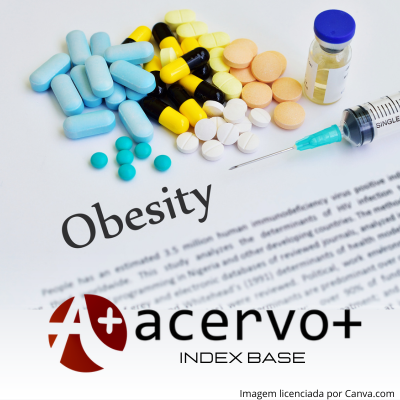Subtipos de obesidade e o impacto do seu conhecimento nas estratégias de tratamento
##plugins.themes.bootstrap3.article.main##
Resumo
Objetivo: Analisar a complexidade da obesidade e classificar os seus subtipos a partir de critérios diagnósticos, além de enfatizar a importância da atividade física e da preservação da aptidão cardiorrespiratória e das abordagens específicas e multidisciplinares necessárias para enfrentamento dessas condições complexas. Revisão bibliográfica: Os quatro tipos de obesidade foram abordados nesta revisão, com distintas características clínicas e metabólicas. Os Obesos Metabolicamente Saudáveis apresentam obesidade, mas, exibem ausência aparente de distúrbios metabólicos associados. Em contraste, os Obesos Metabolicamente Anormais englobam indivíduos com sobrepeso e síndrome metabólica, caracterizando-se por alterações em biomarcadores e um perfil metabólico adverso. A Obesidade Metabólica em Pessoas com Peso Corporal Normal desafia as expectativas, evidenciando distúrbios metabólicos em indivíduos aparentemente dentro dos limites normais de peso. E o Obeso Sarcopênico que apresenta uma interseção desafiadora entre obesidade e perda de massa muscular relacionada à idade, exigindo abordagens para preservar a função física. Considerações finais: Estratégias personalizadas são essenciais para enfrentar a diversidade de fenótipos da obesidade. O entendimento sobre os diversos subtipos é crucial para o desenvolvimento de estratégias mais eficazes na prevenção e tratamento, visando a redução de peso, promoção da saúde metabólica e qualidade de vida.
##plugins.themes.bootstrap3.article.details##
Copyright © | Todos os direitos reservados.
A revista detém os direitos autorais exclusivos de publicação deste artigo nos termos da lei 9610/98.
Reprodução parcial
É livre o uso de partes do texto, figuras e questionário do artigo, sendo obrigatória a citação dos autores e revista.
Reprodução total
É expressamente proibida, devendo ser autorizada pela revista.
Referências
2. BLÜHER M. Metabolically Healthy Obesity. Endocr Rev, 2020; 41(3): bnaa004.
3. BRADSHAW PT, et al. Incidence of components of metabolic syndrome in the metabolically healthy obese over 9 years follow-up: the Atherosclerosis Risk In Communities study. Int J Obes (Lond), 2018; 42(3): 295-301.
4. CHEN Q, et al. Metabolically Abnormal But Normal-Weight Individuals Had a Higher Risk of Type 2 Diabetes Mellitus in a Cohort Study of a Chinese Population. Front Endocrinol (Lausanne), 2021; 12: 724873.
5. COLLELUORI G e VILLAREAL DT. Aging, obesity, sarcopenia and the effect of diet and exercise intervention. Exp Gerontol, 2021; 155: 111561.
6. DE LORENZO A, et al. New obesity classification criteria as a tool for bariatric surgery indication. World J Gastroenterol, 2016; 22(2): 681-703.
7. DE TORO-MARTÍN J, et al. Precision Nutrition: A Review of Personalized Nutritional Approaches for the Prevention and Management of Metabolic Syndrome. Nutrients, 2017; 9(8): 913.
8. DUQUE AP, et al. Emerging concepts in metabolically healthy obesity. Am J Cardiovasc Dis, 2020; 10(2): 48-61.
9. EL BIZRI I e BATSIS JA. Linking epidemiology and molecular mechanisms in sarcopenic obesity in populations. Proc Nutr Soc, 2020; 14.
10. ELLULU MS, et al. Obesity and inflammation: the linking mechanism and the complications. Arch Med Sci, 2017; 13(4): 851-863.
11. HRUBY A e HU FB. The Epidemiology of Obesity: A Big Picture. Pharmacoeconomics, 2015; 33(7): 673-689.
12. HUNTER GR, et al. Sarcopenia and Its Implications for Metabolic Health. J Obes, 2019; 2019: 8031705.
13. KIRWAN JP, et al. The essential role of exercise in the management of type 2 diabetes. Cleve Clin J Med, 2017; 84(71): S15-S21.
14. KOLIAKI C, et al. Defining the Optimal Dietary Approach for Safe, Effective and Sustainable Weight Loss in Overweight and Obese Adults. Healthcare (Basel), 2018; 6(3): 73.
15. KURIYAN R. Body composition techniques. Indian J Med Res, 2018; 148(5): 648-658.
16. LAVIE CJ, et al. Healthy Weight and Obesity Prevention: JACC Health Promotion Series. J Am Coll Cardiol, 2018; 72(13): 1506-1531.
17. LIN H, et al. The prevalence, metabolic risk and effects of lifestyle intervention for metabolically healthy obesity: a systematic review and meta-analysis: A PRISMA-compliant article. Medicine (Baltimore), 2017; 96(47): e8838.
18. LIN X, LI H. Obesity: Epidemiology, Pathophysiology, and Therapeutics. Front Endocrinol (Lausanne), 2021; 12: 706978.
19. MAGKOS F. Metabolically healthy obesity: what's in a name? Am J Clin Nutr., 2019; 110(3): 533-539.
20. MAYORAL LP, et al. Obesity subtypes, related biomarkers & heterogeneity. Indian J Med Res., 2020; 151(1): 11-21.
21. NUTTALL FQ. Body Mass Index: Obesity, BMI, and Health: A Critical Review. Nutr Today, 2015; 50(3): 117-128.
22. PLUTA W, et al. Metabolic Obesity in People with Normal Body Weight (MONW)-Review of Diagnostic Criteria. Int J Environ Res Public Health, 2022; 19(2): 624.
23. RUDERMAN NB, et al. The "metabolically-obese," normal-weight individual. Am J Clin Nutr., 1981; 34(8): 1617-21.
24. SHUSTER A, et al. The clinical importance of visceral adiposity: a critical review of methods for visceral adipose tissue analysis. Br J Radiol., 2012; 85(1009): 1-10.
25. ST-ONGE MP, GALLAGHER D. Body composition changes with aging: the cause or the result of alterations in metabolic rate and macronutrient oxidation?. Nutrition., 2010; 26(2): 152-155.
26. TAK YJ, LEE SY. Long-Term Efficacy and Safety of Anti-Obesity Treatment: Where Do We Stand?. Curr Obes Rep., 2021; 10(1): 14-30.
27. WHARTON S, et al. Obesity in adults: a clinical practice guideline. CMAJ, 2020; 192(31): E875-E891.
28. WILLIAMS R, PERIASAMY M. Genetic and Environmental Factors Contributing to Visceral Adiposity in Asian Populations. Endocrinol Metab (Seoul), 2020; 35(4): 681-695.
29. WU Q, et al. Metabolically healthy obesity: Is it really healthy for type 2 diabetes mellitus?. World J Diabetes, 2022; 13(2): 70-84.
30. YOO EG. Waist-to-height ratio as a screening tool for obesity and cardiometabolic risk. Korean J Pediatr., 2016; 59(11): 425-431.
31. ZAMBONI M, et al. Sarcopenic obesity: a new category of obesity in the elderly. Nutr Metab Cardiovasc Dis., 2008; 18(5): 388-95.

